Abstract
The luminance and color properties of backlight units with quantum-dot (QD) films were investigated through experimentation and optical simulation. Red and green QD films were arranged in four different configurations above and below the light guide plate (LGP). The on-axis luminance of the backlight units with QD films was much larger when diffuse reflectors were used instead of specular reflectors, irrespective of the QD configuration. This result is attributed to the higher color conversion efficiency and the outcoupling efficiency caused by the spreading of the light reflected from the diffuse reflectors. The ‘red QD film-LGP-green QD film’ combination exhibited the highest luminance performance among the four configurations, which can be explained in terms of the reduced radiation load on the two QD films, besides the nearly zero absorption of the red light emitted from the red QD film by the green QD film. The simulation results reproduced all these main results, which indicates that optical simulation can be a useful tool for the optimization of the optical structure of backlight units with QD films in advance of experiment and fabrication.
1. Introduction
Quantum dots (QDs) have arisen as important materials for enhancing the performance of displays and illumination [Citation1–3]. Because of the quantum confinement effects, the emitting wavelength of QDs can be controlled in terms of their size. QD-based backlights have been adopted in liquid crystal display (LCD) technology for achieving a high color gamut [Citation4]. In this case, QDs are usually included in the film to convert the blue exciting light into red and green lights. However, other configurations were also investigated, such as packaged white light-emitting diodes (LEDs) that included QDs [Citation5,Citation6]. On the other hand, QD-based illumination may be used to realize a high color rendering index, or to adopt it for a special purpose such as plant growing [Citation7].
The role of QD films in the backlight is color conversion into white light [Citation8]. Thus, color conversion efficiency is important for higher LCD performance. The color conversion by QD films is affected by several factors in the backlight, such as the combination of the optical films and the location of the light sources. It has been well known that the reflecting properties of the reflection film located beneath the bottom surface of the light guide plate (LGP) have significant effects on the overall efficiency of backlights [Citation9,Citation10]. For example, the light enhancement factor caused by the reflective polarizers in the backlight depends on what kind of reflection film is adopted in the backlight. This is mainly attributed to the fact that the light recycling process that occurs in the backlight is critically dependent on the reflecting properties of the reflection film [Citation11].
However, there has been no study on the effect of reflection films on the color conversion efficiency of QD films for backlight applications, which is the main topic of this study. The researchers focused on the comparison between specular reflectors and diffuse reflectors in terms of the backlight efficiency. In addition, the effect of the QD film configurations on the backlight performance was investigated. Optical simulation was performed to find out the origin of the difference between the two kinds of reflection films.
2. Experiment and simulation
A 13-inch edge-lit backlight was used for the experiment. The light guide plate (LGP) was wedge-type, with a thickness that changed from 5 mm to 2 mm. A total of 38 blue LEDs were attached to the thicker side surface of the LGP, and red and green QD films, denoted as QDR and QDG, respectively, were fabricated at the Cherwon Plasma Research Institute (CPRI). They were CdSe/ZnS QDs, and their thermal stability was significantly enhanced in terms of the replacement of the inorganic ligands [Citation12]. No barrier film was used in the QD films. Typical optical films were used in the backlight, such as a microlens-type diffuser sheet (DS) and two prism sheets (PSs). The two QD films were combined with the LGP in four different combinations: LGP-QDR-QDG, LGP-QDG-QDR, QDR-LGP-QDG, and QDG-LGP-QDR, from bottom to top. In addition, five different reflection films were used under the LGP: two specular reflectors and three diffuse reflectors (Specular 1: Windmöller & Hölscher, Specular 2: 3M, Diffuse 1: embossed-type, Diffuse 2: default film in the notebook, and Diffuse 3: adhesive-type). The reflectance spectra of the four reflectors in the visible range are shown in the supplementary materials (Figure S1). The average reflectance values in the visible range were 83.9% and 89.3% for specular films 1 and 2, respectively, and 92.4% and 96.1% for diffuse films 1 and 3, respectively. The details of the five reflectors and the other optical films can be found elsewhere [Citation10]. Figure (a) shows a schematic diagram of the experimental setup, together with photos of the QD films, optical films, and five reflection films. The backlight was set up on a rotation stage, and its photometric and colorimetric properties were measured using a spectroradiometer (PR670, PhotoResearch). Figure (b) shows a cross-sectional schematic figure of one of the four possible configurations, i.e. the QDG-LGP-QDR configuration.
Figure 1. (Color online) (a) Experimental setup for measuring the angular dependence of the luminance of the backlight units with QD films that had different configurations. (b) Cross-sectional schematic figure of one of the four possible configurations, i.e. the QDG-LGP-QDR configuration.
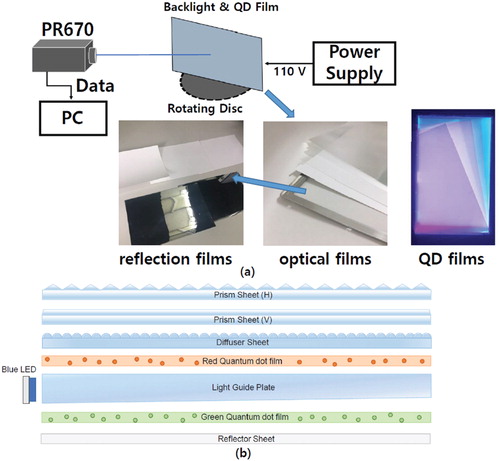
Optical simulation for the backlight unit with QD films using the ray-tracing technique was carried out for comparison with the experiment results. A commercial software (LightTools, Synopsys) was used for the simulation. The absorption, excitation, and emission spectra of both QDs were adopted from the reported values [Citation13]. The mean free path of the QDs in the film was adjusted to control the density of the QD particles. Two kinds of reflectors were adopted: one was a perfect specular reflector and the other, a diffuse reflector with a Gaussian distribution that had a spreading angle of ± 10°. The detailed simulation conditions are shown in Tables and .
Table 1. Simulation conditions of the backlight components.
Table 2. Simulation conditions of QD films and LEDs.
3. Results and discussion
Figures (a) and (b) show the experimental angular dependence of the luminance of the backlight unit with QD films for the specular and diffuse reflectors. The collimated luminance distribution is due to the refracting property of the two PSs. The differences between the two specular reflectors and among the three diffuse reflectors are small. Thus, only two representative results are shown in Figure (Specular 1 vs. Diffuse 2). All the data for the five reflectors can be found in the supplementary materials (Figure S2). There are four combinations for the QD films, as described in the previous section. Figure shows the comparison of the on-axis luminance of all the cases, i.e. the backlights with the five reflectors and four configurations. The systematic comparisons in Figures and show two noticeable results.
Figure 2. (Color online) Angular dependence of the luminance of two backlight units with QD films with (a) a specular reflector (Specular 1) and (b) a diffuse reflector (Diffuse 2). Four different configurations were used for each case.
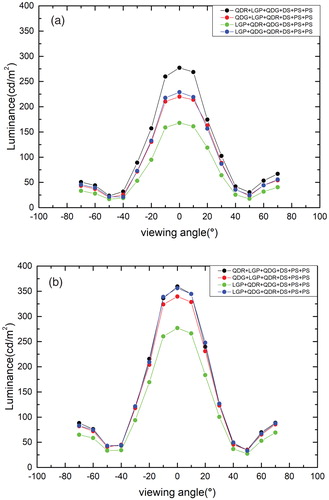
Figure 3. (Color online) Comparison of the on-axis luminance values of all the cases, i.e. the backlights with five reflectors and four configurations (Specular 1: Windmöller & Hölscher, Specular 2: 3M, Diffuse 1: embossed-type, Diffuse 2: default film in the notebook, and Diffuse 3: adhesive-type).
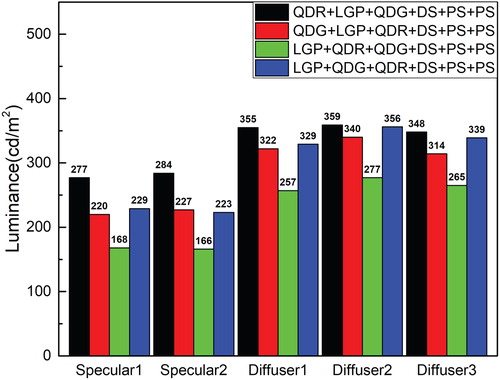
First, the luminance values of the backlights with diffuse reflectors are much larger than those with specular reflectors. This conclusion is valid for all four configurations. The on-axis luminance values of the three backlights with diffuse reflectors are 25% to 65% larger than those of the backlights with specular reflectors, depending on the configuration and type of the diffuse reflectors. One reason for the improvement in the luminance is the difference in the reflectance values of the reflectors. The measured reflectance values of the diffuse reflectors are 3.1% to 12.2% larger than those of the specular reflectors, which definitely reduces the optical loss on the backside of the backlight units. However, the difference in the reflectance may not completely explain the luminance properties, because the luminance improvement is much more substantial, even considering the reflectance differences.
Another reason for the luminance improvement can be suggested based on the reflecting property of the two types of reflectors. In the case of the specular reflectors, the path of the reflected light is solely determined in terms of the law of reflection. It indicates that the light paths in the QD films are very narrow, passing through a smaller volume in the films. This will have three effects on the overall optical efficiency of the backlight units with the QD films. First, the excitation light will sweep out larger volumes under the condition of diffuse reflection, resulting in a higher probability of excitation of the QDs. Second, the radiation load in the illuminated volume of the QD films will be low, and thus, radiation quenching becomes less severe for the diffuse reflectors, resulting in higher color conversion efficiency. That is, the light reflected from the diffuse reflectors has a slight angular distribution, which causes the light to be dispersed in the QD films with a smaller radiation load. This increases the color conversion efficiency in the QD films. In addition, much of the light incident on the other optical films over the QD films is reflected back towards the QD films. In this case, the diffuse reflecting property is again a favorable condition for a smaller radiation load in the QD film and higher color conversion efficiency, compared with the specular reflectors. Third, the diffuse reflecting property is important in reducing the light trapped in the films via the total internal reflection. The randomization of the light propagation direction is helpful in breaking the condition of the total internal reflection in the high-index matrix, and thus, in contributing to the overall outcoupling efficiency. Thus, the much larger luminance values observed from the backlight units with QD films and diffuse reflectors are mainly due to the higher color conversion efficiency and the smaller amount of trapped light in the QD films, compared to the cases with the specular reflectors.
The higher color conversion efficiency can also be confirmed from the data of the color coordinates of all the backlights. Figure shows the angular dependence of the color coordinates of two backlight units with QD films, and a specular reflector (Specular 1) or a diffuse reflector (Diffuse 2). Table shows the comparison of the average color coordinates and their standard deviations for the data shown in Figure . Four different configurations were used for each case. When the reflector changed from the specular type to the diffuse type, the color coordinates of the two backlight units with QD films moved from the bluish and purple areas toward the white point (All the cases are shown in the supplementary materials [Figure S3]). The higher color conversion efficiency increased the portion of the red and green light among the spectra and thus, increased both x and y. However, slight color dispersion can still be seen depending on the viewing angle, which needs further improvement.
Figure 4. (Color online) Angular dependence of the color coordinates of two backlight units with QD films with (a) a specular reflector (Specular 1) and (b) a diffuse reflector (Diffuse 2). Four different configurations were used for each case.
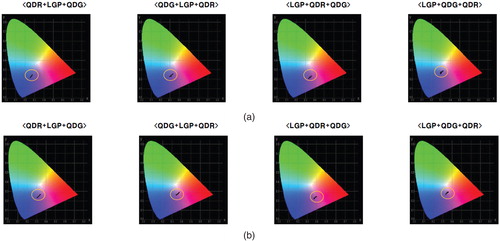
Table 3. Comparison of the average color coordinates and their standard deviations for the data shown in Figure .
Second, the ‘QDR-LGP-QDG’ combination showed the highest luminance values, and the ‘LGP-QDR-QDG’ combination exhibited the lowest luminance values irrespective of the reflectors. In the case of the ‘QDR-LGP-QDG’ combination, the blue light generated from the LEDs was incident on both the QDR and QDG films. This condition reduced the radiation load on both QD films because the excitation source (the blue light) was incident on both QD films located above and beneath the LGP. The results in Figures and show that the ‘QDR-LGP-QDG’ combination is better than the ‘QDG-LGP-QDR’ combination in terms of luminance performance. The red light generated from the QDR could pass through the QDG with little absorption, because the absorption spectrum of the green QD had nearly no absorption band in the red region [Citation13]. However, in the case of the ‘QDG-LGP-QDR’ combination, the green light generated from the QDG film was partly absorbed by the QDR film put over the LGP. This is the reason why the ‘QDR-LGP-QDG’ combination showed the highest luminance values among the four configurations. Between the ‘LGP-QDR-QDG’ and ‘LGP-QDG-QDR’ combinations, the former showed higher color conversion efficiency for the red color, and the latter, for the green color. Since the luminance value was much larger for the green light due to the photopic response, the ‘LGP-QDG-QDR’ combination exhibited larger luminance values than the ‘LGP-QDR-QDG’ combination. However, the ‘LGP-QDG-QDR’ combination still showed smaller luminance than the ‘QDR-LGP-QDG’ combination, due to the heavier radiation load of the blue light on the QD films.
Figures (a) and (b) show the angular dependence of the luminance of the two backlight units with QD films with a specular reflector and a diffuse reflector, respectively, obtained from the optical simulation carried out under the same reflectance of 95%. The intensity polar plots of all the configurations are shown in the supplementary materials (Figure S4). The overall angular dependences of the luminance were nearly the same as those obtained from the experiment, and the luminance distribution was collimated toward the normal direction due to the collimation films.
Figure 5. (Color online) Angular dependence of the luminance of two backlight units with QD films with (a) a specular reflector and (b) a diffuse reflector obtained from optical simulation at the same reflectance of 95%. Four different configurations were used for each case.
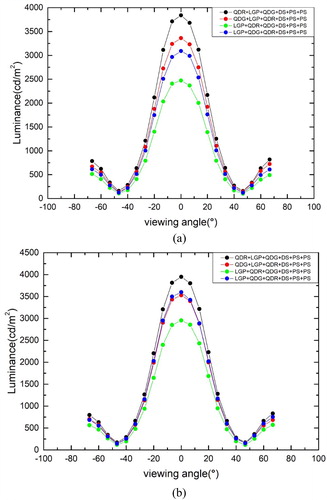
Figure (a) shows the simulation result for the on-axis luminance of the backlight units with QD films, in which specular reflectors were adopted for the four configurations. It also shows the dependence of the on-axis luminance on the reflectivity of the specular reflectors. The luminance increased with increasing reflectivity for all cases, which was expected. In addition, the order of the increases in the on-axis luminance of the four configurations is the same as that obtained from the experiment. This confirms that the division of the radiation load to the two QD films located above and below the LGP is important for obtaining higher luminance values of backlight units with QD films. Moreover, the sequence of the QD films in the backlight is also important for reducing reabsorption of color-converted light via QDs.
Figure 6. (Color online) (a) Dependence of the on-axis luminance on the reflectivity of the specular reflector in the backlight units with QD films obtained by simulation. (b) Comparison of the on-axis luminance values of the specular and diffuse reflectors for four configurations of backlight units with QD films obtained by simulation.

Figure (b) shows the comparison of the on-axis luminance values of the specular reflector and the diffuse reflector at the same reflectivity value of 95%. The backlight with a diffuse reflector exhibited better luminance performance than that with a specular reflector. This result clearly shows that the experimental luminance improvement shown in Figure cannot be solely attributed to the difference in the reflectance values of the two types of reflectors. In addition, the ‘LGP-QDR-QDG’ combination showed much lower luminance values than the other three configurations, which is consistent with the experiment results. This is mainly due to the high ratio of excitation of the red QDs by the blue light emitted from the LGP and the low contribution of the red light to the luminance value. The simulation results shown in Figure indicate that optical simulation can be used as a useful tool for the optimization of the optical structure of backlight units with QD films, which may reduce the development period of this lighting component.
4. Summary
The effects of the reflecting property of the reflector and of the optical configuration of QD films on the luminance and color properties of backlight units with QD films were investigated through experimentation and simulation. The two results clearly showed that the backlight units with QD films exhibited superior luminance performance when the reflector beneath the LGP had a diffuse reflecting property instead of a specular reflecting property. This is attributed to the higher color conversion efficiency, due to the spreading of light and the higher probability of the blue light to strike the QD particles. That is, the blue light reflected from the diffuse reflector passed through the QD films at various angles, which resulted in a larger volume as it passed through the QD films. This suggestion is supported by the changes in the color coordinates, which were closer to the white point when the diffuser reflector was used.
The highest luminance performance was realized in the ‘QDR-LGP-QDG’ combination, and the ‘LGP-QDG-QDR’ combination displayed the lowest luminance value. These results suggest the following implications for the optical design of backlight units with QD films: (1) the radiation load on the QD films should be small enough, (2) the reabsorption of the green light generated from the QDG film by the QDR films needs to be avoided, and (3) the excitation of the QDG film is more important from the viewpoint of the luminance performance.
The consistent results of the experiment and the simulation suggest that optical simulation that includes appropriate QD properties can be a useful tool for the preliminary optimization of the optical structure of backlight units with QD films.
Supplemental Material
Download MS Word (3.3 MB)Disclosure statement
No potential conflict of interest was reported by the author(s).
Additional information
Notes on contributors
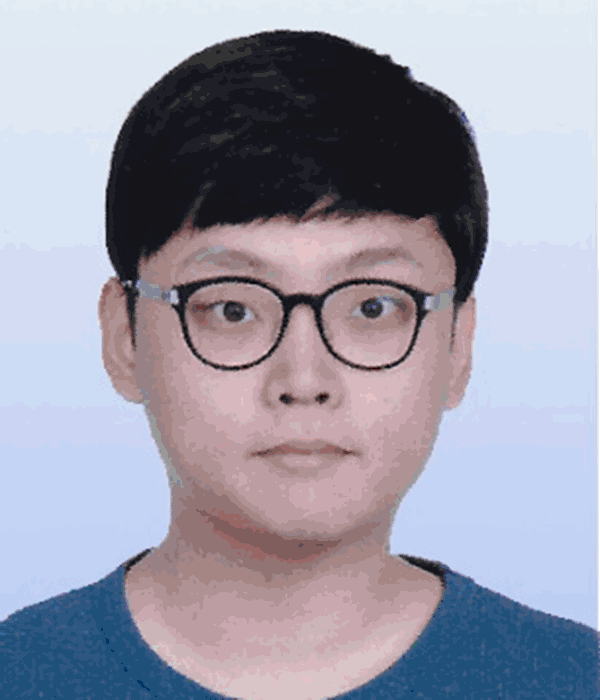
Gi Jung Lee
Gi Jung Lee is a M.S. student of the School of Nano Convergence Technology from Hallym University at present. He has been researched optimization of optical characteristics of quantum-dot based lighting and backlights by using experiment and optical simulation.

Jung-Gyun Lee
Jung-Gyun Lee received the B.S. degree in Department of Physics and M. S. degree in the School of Nano Convergence Technology from Hallym University. He is a researcher of Hallym University at present. He has been researched optimization of optical characteristics of OLED light sources, micro LED-based backlights and quantum-dot lighting technology by using experiment and optical simulation.
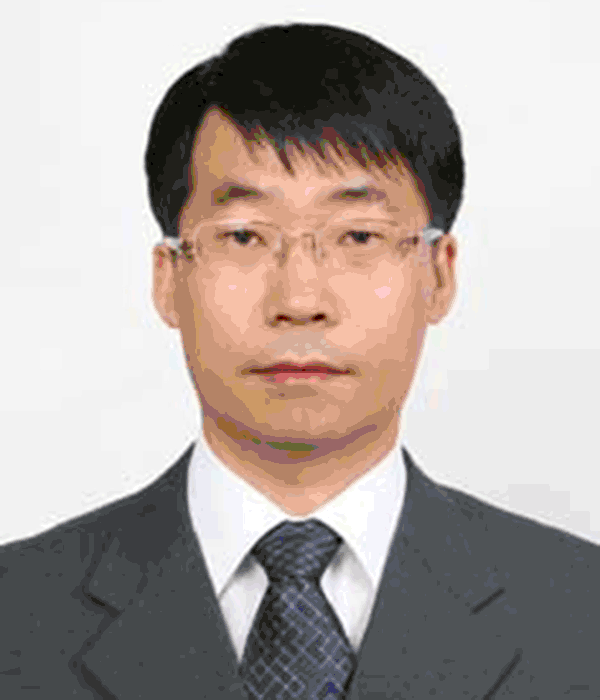
Younduk Kim
Yongduk Kim received the B. S., M.S. and Ph. D. degree in Department of Electrical Enginnering from Kyungpook National University, Korea, in 1995, 1997 and 2006, respectively. From 2002 to 2007, he was a Senior Researcher with Orion Display Co., Ltd. for plasma display, a Section Chief with Sichuan COC Display Company from 2007 to 2010. Since 2011, he has been a Director of Light/Display Convergence R&BD Division with Cheorwon Plasma Research Institute in korea. His research interests include improving the lighting quality of display and lighting devices, and the quantum-dot nano materials for the lighting applications such like natural lighting and plant growth lightings, especially.
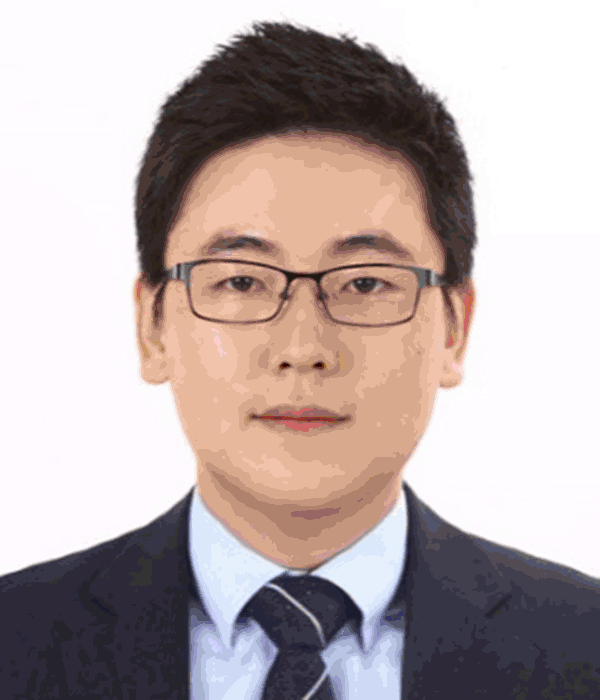
Taehee Park
Taehee Park received the B.S. defree in Department of Chemistry from Myongji University, Korea, in 2008, Ph.D. degree in Department of Chemistry form Hanyang University, Korea, in 2016. Since 2016, he has been a research engineer at Light/Display Convergence R&BD Division, Cheorwon Plasma Research Institute in Korea. He is the suthor of more than 25 articles. His research interests synthesis of quantum dot, stbility of stability of qunatum dot and color convertion material for LED and mico LED
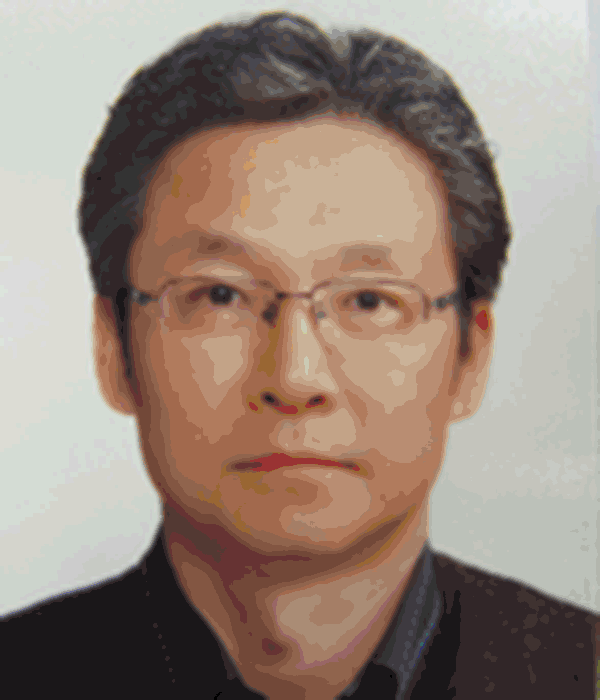
Young Wook Ko
Young Wook Ko received the B. S. degree in Department of Physics from Inha University, Korea, in 1988, M. S. and Ph. D. degree in Department of Physics and Engineering physics Department from Stevens Institute of Technology, U.S.A., in 1991 and 1997, respectively. From 1997 to 2001, he was a deputy general manager with hyundai electronics Co., Ltd for next generation flat display. From 2002 to 2004, he was a Senior Researcher with Electronics and Telecommunications Research Institute for OLED display. From 2005 to 2013, he was a CEO with KDT Co., Ltd, a director of Light/Display Convergence R&BD Division with Cheorwon Plasma Research Institute from 2013 to 2019. Since 2020, he has been a CEO with GL vision Co., Ltd, His research interests include QD micro LED display, flexcible display and QD lighting for smartform, esplecially.
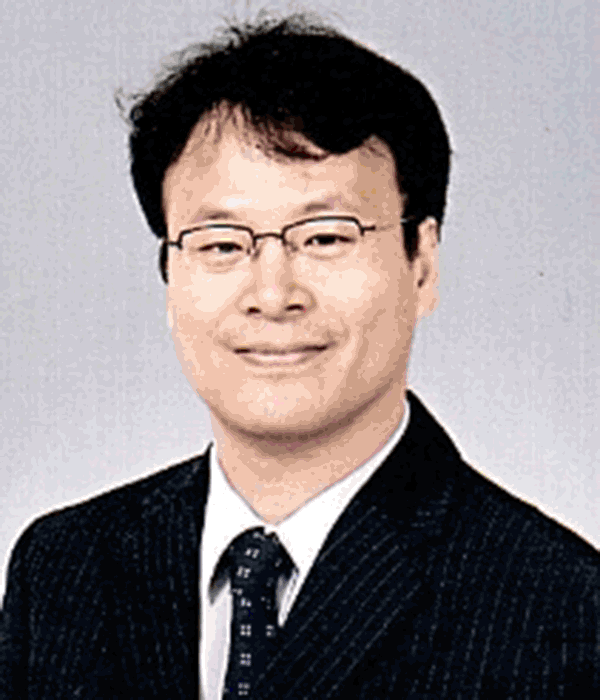
Jae-Hyeon Ko
Jae-Hyeon Ko received the B. S. degree in Department of Physics from Seoul National University, Korea, in 1992, M. S. and Ph. D. degree in Department of Physics from Korea Advanced Science and Technology, Korea, in 1996 and 2000, respectively. From 2000 to 2003, he was a Research Associate with the Institute of Materials Science, University of Tsukuba in Japan. From 2003 to 2004, he was a Senior Researcher with Samsung Corning Co., Ltd. Since 2004, he has been a Professor with the Department of Physics and then the School of Nano Convergence Technology, Hallym University in Korea. He is the author of more than 200 articles and one chapter of two books. His research interests include optical simulation of display and lighting devices, spectroscopic studies on condensed matters including ferroelectrics, dielectrics, and amorphous materials.
References
- D. Bera, L. Qian, T.-K. Tseng, and P.H. Holloway, Materials 3, 2260 (2010). doi: 10.3390/ma3042260
- H.V. Demir, S. Nizamoglu, T. Erdem, E. Mutlugun, N. Gaponik, and A. Eychmüller, Nano Today 6, 632 (2011). doi: 10.1016/j.nantod.2011.10.006
- M.J. Anc, N.L. Pickett, N.C. Gresty, J.A. Harris, and K.C. Mishra, ECS J. Solid State Sci. Technol 2, R3071 (2013). doi: 10.1149/2.016302jss
- Z. Luo, Y. Chen, and S.-T. Wu, Opt. Express 21, 26269 (2013). doi: 10.1364/OE.21.026269
- E. Jang, S. Jun, H. Jang, J. Lim, B. Kim, and Y. Kim, Adv. Mater 22, 3076 (2010). doi: 10.1002/adma.201000525
- S. Abe, J.J. Joos, L.I.D.J. Martin, Z. Hens, and P.F. Smet, Light Sci. Appl 6, e16271 (2017). doi: 10.1038/lsa.2016.271
- L.E. Shea-Rohwer, J.E. Martin, X. Cai, and D.F. Kelley, ECS J. Solid State Sci. Technol 2, R3112 (2013). doi: 10.1149/2.015302jss
- S.J. Kim, H.W. Jang, J.-G. Lee, J.-H. Ko, Y.W. Ko, and Y. Kim, New Phys. Sae Mulli 69, 861 (2019). doi: 10.3938/NPSM.69.861
- M.-Y. Yu, B.-W. Lee, J.H. Lee, and J.-H. Ko, J. Opt. Soc. Korea 13, 256 (2009). doi: 10.3807/JOSK.2009.13.2.256
- S.H. Jeong, A. Park, S.J. Kim, D.J. Park, and J.-H. Ko, New Phys. Sae Mulli 69, 101 (2019). doi: 10.3938/NPSM.69.101
- P. Watson, G.T. Boyd, in Mobile Displays, edited by A.K. Bhowmik, et al. (John Wiley & Sons, Atrium, 2008), Chap. 7. pp. 211–225.
- Y.W. Ko, et al., Korean Patent 10-2018-0138017 (12 November 2018).
- M.H. Shin, H.-J. Kim, and Y.-J. Kim, Opt. Express 25, A113 (2017). doi: 10.1364/OE.25.00A113
